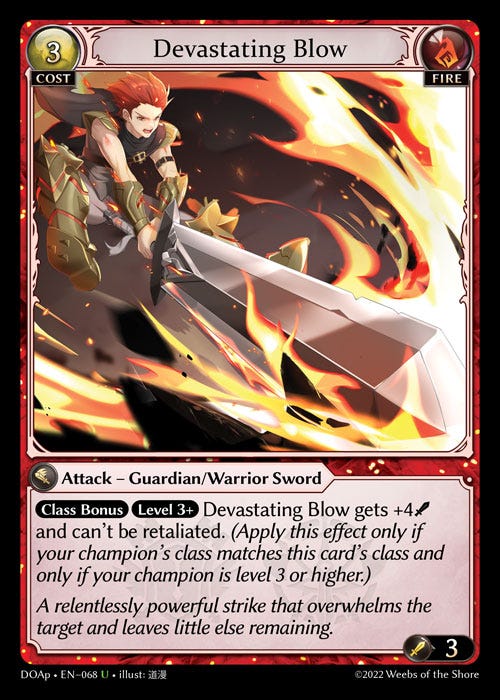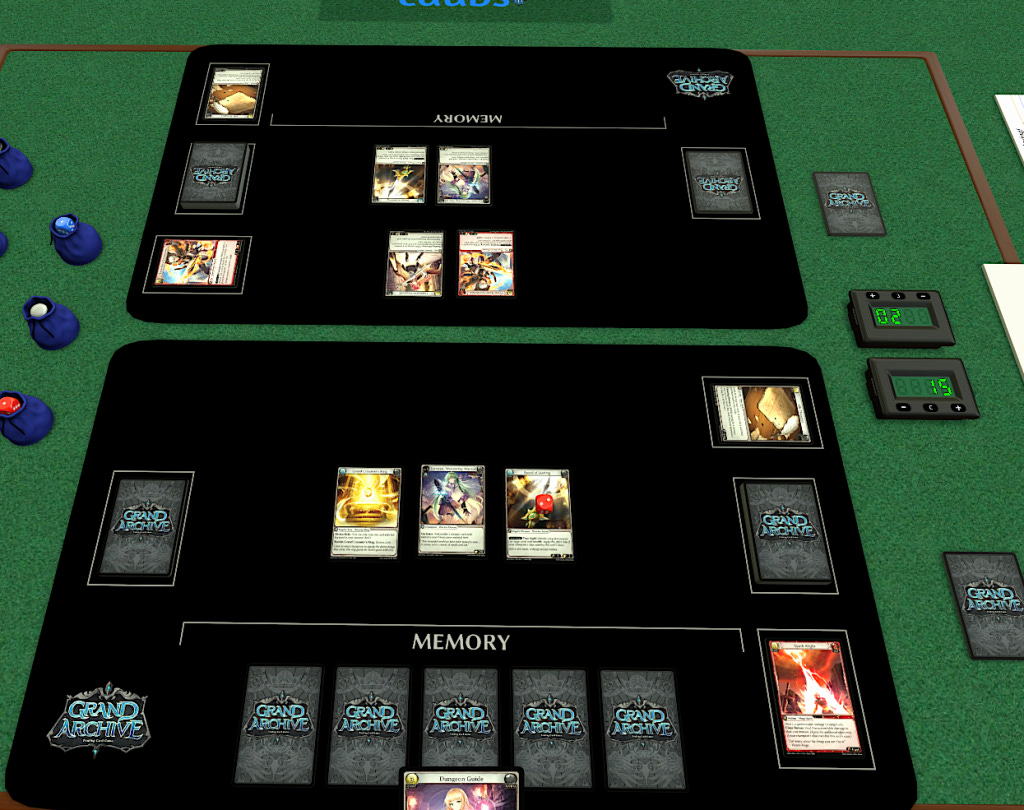So Many (Good) TCGs, So Little Time: A Grand Archive TCG Review
Let me say up front that I apologize for missing my typical Wednesday release. Life is sorta crazy, and honestly, posting just slipped my mind. The good news is that I’ve got a bunch of blog posts in mind, and I’m going to double up this week to make it up to you.
You should also know that I’m probably not going to be focusing exclusively on Flesh and Blood going forward. Before you click away, you should know that it’s because there is so much great stuff happening in this industry. There is simply too much juice to ignore. Games like FaB are having iconic set releases and rules changes (something I promise to react to once we’ve seen enough to how it feels in practice), Magic is back on the map, and new games are peaking over the horizon.
So with that in mind, over the next few weeks, I want to share with you some new games I’ve been playing. In addition to sharing the good and bad of these games, I’ll share any biases I have so that you can interpret my conclusions in their appropriate context.
This week, and probably other weeks to come, we’ll be discussing the Grand Archive TCG.
Grand Archive – The Overview
The Grand Archive TCG describes itself as “[a]n anime TCG with western game design.” I’ll say right at the front: I’m not an anime guy. I don’t mean that disparagingly or anything; I just don’t typically enjoy the art style or some of the common tropes. I’ve watched a couple seasons of a couple of shows (Hunter x Hunter and Sword Art Online), but never really engaged with the medium. So any review I give of this game will come within the context of the art basically doing nothing for me.
GA TCG is a champion centered game where you level up your champion over the course of the game. Just like FaB, there are several classes to choose from, each with a unique play style. The warrior wants to bash things with her swords, the mage wants to light you on fire, and the assassin wants to cheat things sneakily into play. There are more classes, but these are a sampler of things you’ll appreciate if you’re one of my regualar FaB readers.
Just like most TCGs, you have a main deck that consists of creatures, spells, and other actions. The one twist this game has is its unique resource system. When you go to pay the cost of a card, indicated in yellow in the top right corner, you temporarily banish that number of cards from your hand, face down, into your “Memory Zone”. You’ll get (most) of these cards back later.
Then, you have a second deck, called a “Material Deck” that consists of cards you can access once at the beginning your turn. These cards are often weapons and items that let you attack, gain some incremental value, or otherwise interact with your opponent. Think equipment in Flesh and Blood. To cast these Material Deck cards, you’ll permanently banish cards equal to the blue cost in your Memory Zone, at random. So for example, in the photos below, both Grand Crusader’s Ring and Fire Resonance Bauble cost nothing to play (i.e. don’t require permanently banishing cards), but Prismatic Edge requires permanently banishing two cards at random!
After permanently banishing these cards, you’ll pick up what cards are left in your Memory Zone and continue with your turn.
I really enjoyed this aspect of GA TCG. Planning your turn ahead, such that you’re only putting into your Memory Zone what you’re comfortable losing, was a pretty rewarding process. It takes some brain power to plan your turns, and deciding how to maximize hand economy is interesting.
You win once your opponent receives a number of damage counters equal to their champion’s life total. Notably, champions have access to a bigger life pool when they level up (you start with 15), but for the most part, damage counters remain on the champion even after leveling. For example, if I put 5 damage on your Fire Spirit, and you level it up into Level 1 Silvie, your total life pool increases, but you still have 5 damage counters. Just for reference, life is in the bottom right corner of the champion cards next to the little Zelda heart icon.
What I Don’t Love
One of my biggest gripes about the game is that it is so inaccessible right now. I live in a major metropolitan area with several (maybe more than 10? I’ve never actually counted) hobby stores within a 20 minute drive. None of them carry this game, and most of them haven’t heard about it.
The closest store carrying the game is an hour and a half away, and they’ve been sold out for a little while. The closest store with product and tournaments is 2 hours away.
Part of this is that Weebs of the Shore (you either groaned or giggled) is a victim of their own success. FaB fans can relate to that when considering LSS’s growing pains. GA TCG’s Kickstarter was wildly successful. There simply wasn’t enough resources to meet demand.
“I can’t play as much as I want” is one of those complaints that’s really a compliment. It’s akin to “Sometimes I work too hard” when asked about your biggest weakness. I have some actual gripes as a person who taught the game to themselves along with other friends also learning.
The requirements to play a card are a little confusing. Take a look at the card below, Devastating Blow. It’s a Fire (top right corner) Attack – Guardian/Warrior Sword (middle text bar) with a “Class Bonus” (main text box). This card, believe it or not, does not require you to be a Guardian or Warrior, nor have a sword. It only requires you to have Fire in your lineage. (I don’t want to get too much into it here, but your Lineage is a compendium of your champion’s history as you level them up. Everyone starts as an elemental spirit and then levels up into a class.)
Several times throughout learning the game, we asked, “Can I play this card in my deck?” Most of the time, the answer was yes, but it took us a little bit to figure out why. For Devastating Blow, it functions as an attack for 3, and you can do that so long as you have Fire lineage. You get the text box, i.e. the Class Bonus, if your hero shares a class with the card itself. Here, that’s Guardian or Warrior. Some cards will have some text locked behind Class Bonus but not others. There can be a lot going on.
This confusion point, of course, isn’t defeating. After all, part of this came from assumptions we made about the game. FaB has class restrictions, so we imparted them onto this game without fully reading the rules. Now, I think our mistake was reasonable. After all, most games have class restrictions on gear type, skills, or other customizable components.
That being said, knowing that deck building is wide open, and that you’re less restricted than you expect, is a silver lining of this misunderstanding.
I have other nitpick things about this game (like the rules just changed in a massive way, and the start of game procedure just feels clunky), but by and large, they’re doing things well. Let’s talk about some of those.
Things I Love
There is extreme deck diversity in this game. Here’s a link to a tournament reports website. You’ll notice that Lorraine is kind of cleaning up right now, but even then, there are 3+ ways to build each champions. So even if Wind Lorraine is top dog, there are other strong heroes and multiple ways to build them. Almost everything feels playable at top tables (RIP Silvie).
I also like how GA TCG is approaching their banning process. While I hinted that I lament a rule change they just made, I really appreciate their banned and restricted policy. They’ve introduced a tiered system to track how problematic some cards are and how close they might be to being banned.
Category 3 cards are those that are banned or restricted. There are currently no cards banned or restricted.
Category 2 cards are those that are “very problematic” and may get banned in the future.
Category 1 cards are those they “don’t consider problematic in the current environment, but are unhealthy for future balance and game design space.”
My biggest gripe with bans and restrictions is that they invalidate player purchases. Spending $70 on a play-set of a card, only for it to get banned out from underneath you, feels very bad. With this system, you have a bit more information on whether you want to invest heavily in a card that the designers consider very problematic. Now, if you drop $70 on a play-set and it gets banned, you had agency in that decision.
I also love the actual game play itself. The Memory Zone mechanic, like I mentioned, induces a lot of decision making and planning. The cards themselves look unremarkable based on their stat lines, but leveraging the most out of those cards, and setting up combos/efficient interactions is satisfying. I’ve played only a handful of games casually, but I’ve never walked away feeling like I’ve wasted my time.
The Conclusion
I’m going to rate this game a 7.5 out of 10, with the option for it to go much higher. I’ve opened a lot of product for the game already (TCG Player has a lot of product available), and it’s definitely a fun open. I’m sure once I get some tournaments under my belt, I’ll be even more excited to play than I was today. Just for fun, here’s a screen shot of a game I played with Flake not to long ago on TTS.
If you’re looking for an actual Learn to Play video, or want to see some game play, check out the videos below.
If you’ve read this far, I’d greatly appreciate it if you’d consider subscribing, for free, to this newsletter. The weekly newsletter will hopefully grow as I get feedback and experience, and I truly look forward to sharing it with everyone.
Next week: pickles (transcribing audio is hard), Alpha Clash TCG review, or something else.
Also: people asked me to set up a Patreon…probably not, but I appreciate it Just tell your friends.



